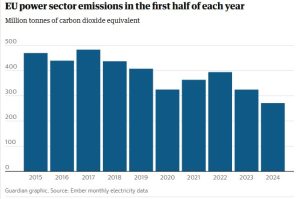Wind and Solar Energy Surpass Fossil Fuels to Provide 30% of EU Electricity
In a landmark achievement for renewable energy, wind turbines and solar panels have overtaken fossil fuels to generate 30% of the European Union’s electricity in the first half of 2024, according to a report by climate thinktank Ember. This significant shift marks a 17% decline in power generation from coal, oil, and gas compared to the same period last year. The continued movement away from polluting fuels has led to a one-third reduction in the sector’s emissions since the first half of 2022.
Chris Rosslowe, an analyst at Ember, described the trend as a “historic shift in the power sector” and noted that it is happening rapidly. The report highlights that 13 EU member states, including Germany, Belgium, Hungary, and the Netherlands, generated more electricity from wind and solar than from fossil fuels for the first time.
The shift toward renewable energy comes amidst a slight increase in electricity demand following two years of decline linked to the COVID-19 pandemic and the ongoing conflict in Ukraine. Rosslowe emphasized the importance of maintaining momentum in wind and solar deployment to reduce dependence on fossil fuels.
Despite the progress in solar power, the wind industry faces challenges due to high inflation and opposition from politicians and the public. The EU installed a record 16.2GW of new wind power capacity in 2023, as reported by Wind Power Europe, but this still fell short of the necessary target to meet the EU’s climate goals for the decade.
Scenarios from the Intergovernmental Panel on Climate Change (IPCC) and the International Energy Agency indicate that most electricity for a clean economy will come from solar and wind energy. Andrea Hahmann, a scientist at Denmark Technical University and co-author of an IPCC report chapter on energy systems, commented that the development was “significant but not surprising,” citing strong winds in northern Europe during the first half of 2024 as a contributing factor.
The report underscores that the EU’s electricity transition is feasible and urges continued policy support to achieve ambitious renewable energy targets. It also clarifies that while wind and solar contribute 30% of the EU’s electricity, the inclusion of other renewables such as hydropower raises the total share to 50%.
This article’s headline was updated on 30 July 2024 to specify that wind and solar energy make up 30% of EU electricity. The graphics were also updated to reflect that the data encompass the entire EU, not just the 13 member states highlighted in the report.







